Devon DeJardin and Spiritual “Guardians”
After a large introductory splash in the LA art scene, Devon DeJardin sat down to discuss his success, “Guardians” and his career’s next steps.
When asked about his mission is in his artistic work, Devon DeJardin is quick to catch himself.
“I want people to feel invited into the space, to sit with the work, to be still, to question it, and to find something authentic within themselves through the piece,” he starts.
Then, immediately, he qualifies: “I know everyone says that, ‘I want people to feel something,’ whatever.”
“But it’s true,” he continues. “As artists we want to strike a chord with someone – whatever that may be.”
Talking with DeJardin, a 25-year-old up-and-comer in the LA art scene, you can tell he means it. He has a familiar SoCal-casual manner of speech: he cuts himself off, he qualifies his statements, he speaks in rapid fragments that each feel like a fresh attempt to express what it is he’s really trying to say.
In other words, even the way he talks feels like a form of searching. And it makes sense. In a way, he’s been searching all his life – and even though he’s achieved professional success most artists only dream of, he feels as though he’s more unfinished, and searching harder, than ever.
The Shortest Route From Point A to Point B
For DeJardin, uncertainty is nothing new. Time and again throughout his life, it seems as if the least obvious choice ended up being the right one.
When he was fourteen, he founded a clothing brand with his brother. They started by uploading scans of DeJardin’s work and selling it to friends, but eventually their clothes were selling in premium labels and stores in 16 countries. When he moved to Los Angeles for college, he focused on neither art nor fashion, instead spending his time studying world religions.
While this may seem like an odd path for an artist, these experiences ended up playing important roles in his art. His first series, entitled “Guardians,” sought to explore and depict the idea of a spiritual guardian without painting itself into a theological corner.
“I wanted to take what I’d learned and put it into art,” he says of his process for Guardians.
“Most religions include some concept of a spiritual guardian – in Christianity you have Christ, in Hinduism you have the devas,” he continues. “I wanted to create a reflection of a spiritual guardian that extended beyond just one single religion’s view.”
The series was a huge success. DeJardin sold 90% of the work to buyers including both millionaire real estate developers and board members of LACMA, all without official representation or a single gallery showing.
“The attention it got was ridiculous, and it was all just through Instagram and word of mouth,” he recalls. “And I mean my Instagram isn’t even that big, I have like 20K or something. But what that showed me, I think that was one of my first moments when I realized that art really does speak to people if you create the platform for it to be heard.”
Turning Back, Turning Within
“Guardians” catapulted DeJardin into the LA art scene and firmly established him as one of LA’s top new visual artists to watch. But just as his non-linear past is what helped shape his art, his newfound success is proving to be both a blessing and a curse.
At the moment, DeJardin is in the midst of developing a new set of pieces for a showing at the end of summer. And while he’s grateful for the success of “Guardians,” it casts a long shadow.
“It’s a little difficult now because – I mean, I introduced myself to the art world with something I’d worked on for years to execute perfectly,” he says. “But I feel like I need to keep growing and developing, and now I’m trying to find where is that new subject, where can I dig into my core and find something that really comes from my heart?”
To do that, he’s had to turn within, and revisit one of the most formative – and painful – periods of his life.
“Honestly a big part of my story was, like when I was 16 or 17 I went through very intense counseling and therapy for anxiety & depression,” he says. “I mean really, really intense – I’m talking 3 hours a day, 3 days a week, for maybe two and a half years.”
“During that time, it just – I mean you feel like the world is gone. Everything is… out,” he continues. “But that darkness is what forced me to spend the time talking it out, working through that rough period and pulling apart those emotions… and I think that, more than anything else, that’s what enabled me to put myself into the art and develop a voice that speaks to people.”
Now, he’s looking to draw on that turmoil as a way to deepen his work.
“With Guardians, it was about exploring and synthesizing different worldviews and perspectives, it was about looking outward,” he says. “So now, one of the things I want to do with the new series is dive deeper into the concept, but reflecting on the emotional turmoil of my past.”
It’s a process that’s required him to put in real work in his own personal development and practice. These days, he says he spends as much time meditating and searching within as he does painting and drawing.
With his upcoming Los Angeles show tentatively slated for August, DeJardin is in an intense process of searching. In our conversation, it was clear that he felt a deep sense of uncertainty, and it seemed as though he was actively trying to find the answer in every response he gave.
But just as uncertainty and instability has played a creative, generative role in his life, this very process of searching is helping him grow both as an artist and a person.
“The more I think about my own identity as a person, as a human, the more I realize my work is the thing that really matters,” he says. “That’s what’s me.”
It’s a beautiful example of how so often, in our modern world of comfort and convenience, the very uncertainty and discomfort we seek to avoid is the thing we most need in order to move forward. How the journey is the destination, and how only once we recognize that fact can we reach the place we want to.
DeJardin’s work, for now, focuses on guardians – on entities and forces that protect us, guide us, and challenge us to grow. But often, our real life ‘guardians’ come in forms we don’t recognize: challenges that force us to learn new skills, losses that teach us emotional resilience, crises that show us our inner strength.
“In a way, art itself has always been a guardian for me,” he says, reflective. “Maybe that’s the thing I’ve been trying to express this whole time.”



